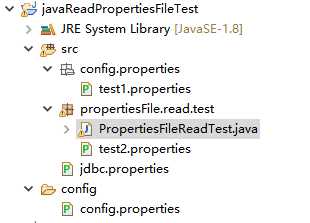java读取properties文件总结
Posted tanlei-sxs
tags:
篇首语:本文由小常识网(cha138.com)小编为大家整理,主要介绍了java读取properties文件总结相关的知识,希望对你有一定的参考价值。
一、java读取properties文件总结
在java项目中,操作properties文件是经常要做的,因为很多的配置信息都会写在properties文件中,这里主要是总结使用getResourceAsStream方法和InputStream流去读取properties文件,使用getResourceAsStream方法去读取properties文件时需要特别注意properties文件路径的写法,测试项目如下:

/* 范例名称:java读取properties文件总结 * 源文件名称:PropertiesFileReadTest.java * 要 点: * 1. 使用getResourceAsStream方法读取properties文件 * 2. 使用InPutStream流读取properties文件 * 3. 读取properties文件的路径写法问题 * **/ package propertiesFile.read.test; import java.io.BufferedInputStream; import java.io.FileInputStream; import java.io.FileNotFoundException; import java.io.IOException; import java.io.InputStream; import java.text.MessageFormat; import java.util.Properties; public class PropertiesFileReadTest { public static void main(String[] args) throws FileNotFoundException { readPropFileByGetResourceAsAtream(); System.out.println("--------------"); //readPropFileByInPutStream(); } /* * 使用getResourceAsAtream方法读取 */ private static void readPropFileByGetResourceAsAtream() { /* * 读取src下面config.properties包内的配置文件 test1.properties位于config.properties包内 */ InputStream inl = PropertiesFileReadTest.class.getClassLoader() .getResourceAsStream("config/properties/test1.properties"); /* * 读取和PropertiesFileReadTest类位于同一个包里面的配置文件 * test2.properties和PropertiesFileReadTest类在同一个包内 */ InputStream in2 = PropertiesFileReadTest.class.getResourceAsStream("test2.properties"); /* * 读取src根目录下文件的配置文件 jdbc.properties位于src目录 */ InputStream in3 = PropertiesFileReadTest.class.getClassLoader().getResourceAsStream("jdbc.properties"); /* * 读取位于另一个source文件夹里面的配置文件 config是一个source文件夹,config.properties位于config * source文件夹中 */ InputStream in4 = PropertiesFileReadTest.class.getClassLoader().getResourceAsStream("config.properties"); Properties properties = new Properties(); System.out.println("----使用getResourceAsStream方法读取properties文件----"); // 从输入字节流读取属性列表(键,值) try { System.out.println("-----------------------"); properties.load(inl); System.out.println("test1.properties:name=" + properties.getProperty("name") + ",age=" + properties.getProperty("age")); System.out.println("-----------------------"); System.out.println("-----------------------"); properties.load(in2); System.out.println("test2.properties:name=" + properties.getProperty("name") + ",age=" + properties.getProperty("age")); System.out.println("-----------------------"); properties.load(in3); System.out.println("jdbc.properties:"); // 使用指定的格式字符串和参数返回格式化的字符串, 这里的%s是java String占位符 System.out.println(String.format("jdbc.url=%s", properties.getProperty("jdbc.url"))); System.out.println(String.format("jdbc.usename=%s", properties.getProperty("jdbc.usename"))); System.out.println(String.format("jdbc.password=%s", properties.getProperty("jdbc.password"))); properties.load(in4); System.out.println("config.properties:"); // 使用给定的模式创建一个MessageFormat,并使用它来格式化给定的参数,{0}是一个java的字符串占位符 System.out.println(MessageFormat.format("dbuser={0}", properties.getProperty("dbuser"))); System.out.println(MessageFormat.format("dbpassword={0}", properties.getProperty("dbpassword"))); System.out.println(MessageFormat.format("database={0}", properties.getProperty("database"))); System.out.println("----------------------------------------------"); } catch (IOException e) { // TODO Auto-generated catch block e.printStackTrace(); }finally { if(inl != null) { try { inl.close(); } catch (IOException e) { e.printStackTrace(); } } if(in2 != null) { try { inl.close(); } catch (IOException e) { e.printStackTrace(); } } if(in3 != null) { try { inl.close(); } catch (IOException e) { e.printStackTrace(); } } if(in4 != null) { try { inl.close(); } catch (IOException e) { e.printStackTrace(); } } } }
/* * 使用InputStream流读取properties */ private static void readPropFileByInPutStream() throws FileNotFoundException { InputStream in1=null; InputStream in2=null; InputStream in3=null; InputStream in4=null; System.out.println("----使用InputStream流读取properties文件----"); try { /* * 读取src下面config.properties包内的配置文件 test1.properties位于config.properties包内 */ in1 =new BufferedInputStream(new FileInputStream("src/config/properties/test1.properties")); /* * 读取和PropertiesFileReadTest类位于同一个包里面的配置文件 * test2.properties和PropertiesFileReadTest类在同一个包里面 */ in2=new BufferedInputStream(new FileInputStream("src/propertiesFile/read/test/test2.properties")); /* * 读取src根目录下文件的配置文件 * jdbc.properties位于src目录 */ in3 = new BufferedInputStream(new FileInputStream("src/jdbc.properties")); /* * 读取位于另一个source文件夹里面的配置文件 * config是一个source文件夹,config.properties位于config source文件夹中 */ in4 = new FileInputStream("config/config.properties"); Properties properties=new Properties(); System.out.println("-----------------------"); properties.load(in1); System.out.println("test1.properties:name=" + properties.getProperty("name") + ",age=" + properties.getProperty("age")); System.out.println("-----------------------"); System.out.println("-----------------------"); properties.load(in2); System.out.println("test2.properties:name=" + properties.getProperty("name") + ",age=" + properties.getProperty("age")); System.out.println("-----------------------"); properties.load(in3); System.out.println("jdbc.properties:"); // 使用指定的格式字符串和参数返回格式化的字符串, 这里的%s是java String占位符 System.out.println(String.format("jdbc.url=%s", properties.getProperty("jdbc.url"))); System.out.println(String.format("jdbc.usename=%s", properties.getProperty("jdbc.usename"))); System.out.println(String.format("jdbc.password=%s", properties.getProperty("jdbc.password"))); properties.load(in4); System.out.println("config.properties:"); // 使用给定的模式创建一个MessageFormat,并使用它来格式化给定的参数,{0}是一个java的字符串占位符 System.out.println(MessageFormat.format("dbuser={0}", properties.getProperty("dbuser"))); System.out.println(MessageFormat.format("dbpassword={0}", properties.getProperty("dbpassword"))); System.out.println(MessageFormat.format("database={0}", properties.getProperty("database"))); System.out.println("----------------------------------------------"); } catch (IOException e) { // TODO Auto-generated catch block e.printStackTrace(); }finally { if (in1 != null) { try { in1.close(); } catch (IOException e) { e.printStackTrace(); } } if (in2 != null) { try { in2.close(); } catch (IOException e) { e.printStackTrace(); } } if (in3 != null) { try { in3.close(); } catch (IOException e) { e.printStackTrace(); } } if (in4 != null) { try { in4.close(); } catch (IOException e) { e.printStackTrace(); } } } }
以上是关于java读取properties文件总结的主要内容,如果未能解决你的问题,请参考以下文章